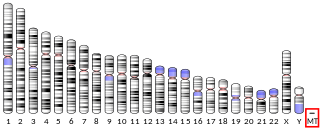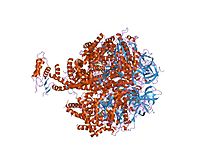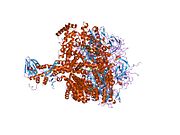
ATPases (EC 3.6.1.3, Adenosine 5'-TriPhosphatase, adenylpyrophosphatase, ATP monophosphatase, triphosphatase, SV40 T-antigen, ATP hydrolase, complex V (mitochondrial electron transport), (Ca2+ + Mg2+)-ATPase, HCO3−-ATPase, adenosine triphosphatase) are a class of enzymes that catalyze the decomposition of ATP into ADP and a free phosphate ion or the inverse reaction. This dephosphorylation reaction releases energy, which the enzyme (in most cases) harnesses to drive other chemical reactions that would not otherwise occur. This process is widely used in all known forms of life.

ATP synthase is an enzyme that catalyzes the formation of the energy storage molecule adenosine triphosphate (ATP) using adenosine diphosphate (ADP) and inorganic phosphate (Pi). ATP synthase is a molecular machine. The overall reaction catalyzed by ATP synthase is:

MT-ATP8 is a mitochondrial gene with the full name 'mitochondrially encoded ATP synthase membrane subunit 8' that encodes a subunit of mitochondrial ATP synthase, ATP synthase Fo subunit 8. This subunit belongs to the Fo complex of the large, transmembrane F-type ATP synthase. This enzyme, which is also known as complex V, is responsible for the final step of oxidative phosphorylation in the electron transport chain. Specifically, one segment of ATP synthase allows positively charged ions, called protons, to flow across a specialized membrane inside mitochondria. Another segment of the enzyme uses the energy created by this proton flow to convert a molecule called adenosine diphosphate (ADP) to ATP. Subunit 8 differs in sequence between Metazoa, plants and Fungi.

MT-ATP6 is a mitochondrial gene with the full name 'mitochondrially encoded ATP synthase membrane subunit 6' that encodes the ATP synthase Fo subunit 6. This subunit belongs to the Fo complex of the large, transmembrane F-type ATP synthase. This enzyme, which is also known as complex V, is responsible for the final step of oxidative phosphorylation in the electron transport chain. Specifically, one segment of ATP synthase allows positively charged ions, called protons, to flow across a specialized membrane inside mitochondria. Another segment of the enzyme uses the energy created by this proton flow to convert a molecule called adenosine diphosphate (ADP) to ATP. Mutations in the MT-ATP6 gene have been found in approximately 10 to 20 percent of people with Leigh syndrome.

ATPase, subunit C of Fo/Vo complex is the main transmembrane subunit of V-type, A-type and F-type ATP synthases. Subunit C was found in the Fo or Vo complex of F- and V-ATPases, respectively. The subunits form an oligomeric c ring that make up the Fo/Vo/Ao rotor, where the actual number of subunits vary greatly among specific enzymes.

ATP synthase F1 subunit beta, mitochondrial is an enzyme that in humans is encoded by the ATP5F1B gene.

ATP synthase F1 subunit alpha, mitochondrial is an enzyme that in humans is encoded by the ATP5F1A gene.

ATP synthase-coupling factor 6, mitochondrial is an enzyme subunit that in humans is encoded by the ATP5PF gene.

The ATP5MC1 gene is one of three human paralogs that encode membrane subunit c of the mitochondrial ATP synthase.

The ATP5MF gene encodes the ATP synthase subunit f, mitochondrial enzyme in humans.

The alpha and beta subunits are found in the F1, V1, and A1 complexes of F-, V- and A-ATPases, respectively, as well as flagellar (T3SS) ATPase and the termination factor Rho. The subunits make up a ring that contains the ATP-hydrolyzing catalytic core. The F-ATPases, V-ATPases and A-ATPases are composed of two linked complexes: the F1, V1 or A1 complex containsthat synthesizes/hydrolyses ATP, and the Fo, Vo or Ao complex that forms the membrane-spanning pore. The F-, V- and A-ATPases all contain rotary motors, one that drives proton translocation across the membrane and one that drives ATP synthesis/hydrolysis.

ATP synthase delta subunit is a subunit of bacterial and chloroplast F-ATPase/synthase. It is known as OSCP in mitochondrial ATPase.

ATP synthase subunit g, mitochondrial is an enzyme that in humans is encoded by the ATP5MG gene.

The human ATP5F1C gene encodes the gamma subunit of an enzyme called mitochondrial ATP synthase.

ATP synthase subunit b, mitochondrial is an enzyme that in humans is encoded by the ATP5PB gene.

The ATP5MC2 gene is one of three human paralogs that encode membrane subunit c of the mitochondrial ATP synthase.

ATP synthase subunit e, mitochondrial is an enzyme that in humans is encoded by the ATP5ME gene.

The human gene ATP5PD encodes subunit d of the peripheral stalk part of the enzyme mitochondrial ATP synthase.

ATP synthase subunit delta, mitochondrial, also known as ATP synthase F1 subunit delta or F-ATPase delta subunit is an enzyme that in humans is encoded by the ATP5F1D gene. This gene encodes a subunit of mitochondrial ATP synthase. Mitochondrial ATP synthase catalyzes ATP synthesis, utilizing an electrochemical gradient of protons across the inner membrane during oxidative phosphorylation.

The ATP5MC3 gene is one of three human paralogs that encode membrane subunit c of the mitochondrial ATP synthase.




























